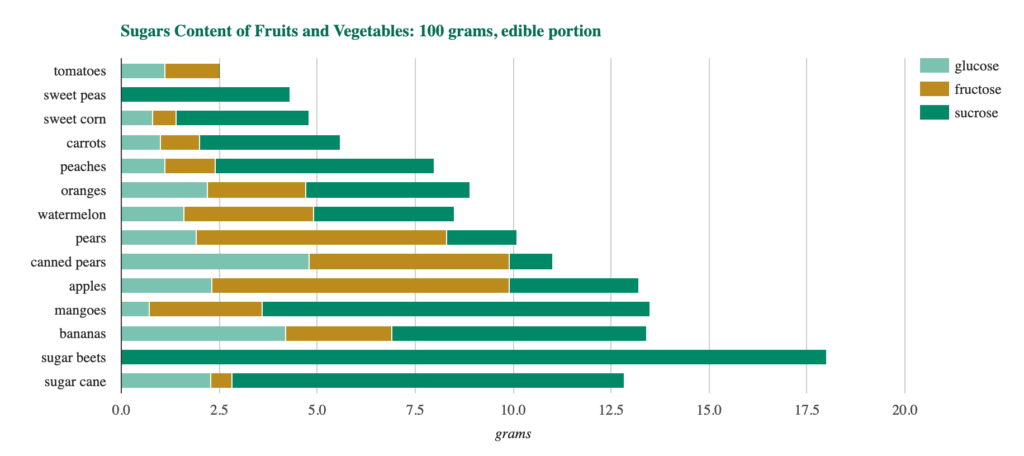Sucrose is the most abundant form of sugar and can be found occurring naturally in whole foods like fruits, vegetables and nuts (1). Sucrose is most commonly referred to as ‘table sugar’ or ‘granulated sugar’. This sugar is used on a daily basis to sweeten hot beverages such as tea and coffee and is also used as part of traditional baking recipes for cupcakes, muffins and more. Granulated sugar is largely extracted from sugar cane or sugar beets and is typically sold without the plant source identified because the two products (chemically speaking) are identical. Sucrose is extensively added to food products to provide flavour, aroma, texture, colour and shelf-life stability.
Sucrose is a type of carbohydrate that can be classified as a disaccharide (a class of sugars whose molecules contain two monosaccharide residues), made of equal parts of two monosaccharides: glucose and fructose. Consumption of sucrose from whole food sources is not considered to have negative impacts on metabolic health (2), due to the fibre content of these foods which helps to slow down glucose absorption. Examples of these foods include:
- bananas
- mangoes
- sweet peas
- sweet corn
- pistachios
- Brazil nuts
- oranges
- peaches
- pineapples
- watermelon
- carrots
However, overconsumption of sucrose as an added sugar can lead to adverse health effects such as insulin resistance, blood sugar spikes and increased risk of obesity, which negatively impact our metabolic health (3). Examples of these foods include:
- cakes
- bread
- cereals
- breakfast bars
- chocolate
- candy
- sweetened beverages
- adding sugar to tea/coffee
- condiments (ketchup/BBQ sauce)
What is the difference between sucrose, fructose and glucose?
Sucrose
Sucrose is a disaccharide made up of 50% glucose and 50% fructose (4). It is a naturally occurring carbohydrate found in a variety of fruits, vegetables and nuts. Sucrose is also used as an added sugar in processed foods such as ice creams, cakes and cereals as well as sweetened beverages (which includes adding a teaspoon of sugar to tea or coffee).
Sucrose is sweeter than glucose but not as sweet as fructose. Sucrose is absorbed into the bloodstream through the small intestine, where the enzyme sucrase (5) (which is made by the lining of the small intestine) divides sucrose into glucose and fructose. Digestion of sucrose can also occur in the mouth, where enzymes split sucrose into glucose and fructose ready to be used by the body.
Glucose
Glucose is a monosaccharide (also known as a simple sugar) and is the body’s preferred energy source because it can be absorbed directly into the bloodstream through the lining of the small intestine (5). Monosaccharides consist of one single unit of sugar and are the building blocks of carbohydrates. Glucose causes a spike in blood sugar and stimulates the release of insulin; this can have a negative impact on metabolic health if not regulated. When blood sugar levels are depleting, glycogen is broken down into glucose to be used for energy (6). Glucose is commonly bound to other simple sugars to form disaccharides or polysaccharide starches and is the least sweet of the three sugars.
Fructose
Fructose is another form of monosaccharide and is often referred to as ‘fruit sugar’ due to its natural occurrence in many fruits, particularly tropical fruits such as mangoes, pineapples, plantain and bananas. Fructose is also commonly found in honey, agave and root vegetables. As a monosaccharide, fructose is easily absorbed directly in the small intestine and into the bloodstream (5). Although this sugar raises blood sugar levels at a more gradual pace than glucose, it may have more detrimental long-term effects on metabolic health and has been shown to increase blood triglyceride levels (7). High fructose corn syrup is made from cornstarch and sugar cane/sugar beets and is frequently added to highly processed foods. These foods are often over-consumed and in large amounts, because of which the risk of developing metabolic syndrome (3) and non-alcoholic fatty liver disease (NAFLD) are greatly increased (8). Fructose is the sweetest out of all three sugars.

How is sucrose made?
Sucrose is made from 50% glucose and 50% fructose. Although sucrose is a naturally occurring sugar found in multiple whole food sources, it is also produced commercially from either sugar cane or sugar beets. Sucrose is made naturally in plants through photosynthesis (2). The sugars produced are stored in the root, leaf, seed or fruit of the plant. Sugar cane and sugar beets contain higher proportions of sucrose compared to other plants that can be harvested to create what we know as table sugar or added sugars. Whilst both plants require different conditions in which to grow, the finished products (granulated sugar/table sugar) are both exactly the same—pure sucrose. To produce the final product, i.e., granulated sugar, multiple steps need to be taken, which include harvesting the sugar cane/sugar beet and extracting the juice that comes from it (9). This liquid is then refined numerous times to isolate sucrose, leaving the finished crystallised product of table sugar.
How does sucrose impact the body?
Sucrose found in whole foods such as fruits, nuts and vegetables is not considered detrimental to human health. These foods are accompanied by plenty of fibre, which slows down the absorption of sugars and prevents blood sugar spikes. Therefore, they do not damage metabolic health. These foods also contain an abundance of vitamins, minerals and phytonutrients, which are beneficial to human health.
Studies have shown how overconsumption of sucrose (in the form of added sugars) can lead to multiple metabolic dysfunctions such as metabolic syndrome, increased inflammation, insulin resistance, obesity, hypertension, raised blood triglyceride levels and increased risk of developing cardiovascular disease (CVD) (10).
Sucrose found in highly processed foods such as cakes, cereals and sweetened beverages has been demonstrative of negatively impacting human metabolic health. When consumed in foods that are classed as having ‘empty calories‘ (meaning they lack fibre and other essential nutrients but have a high caloric load), they stimulate a spike in blood glucose levels. In the long term, these spikes in blood glucose can lead to metabolic dysfunction such as insulin resistance; they may even result in the rupturing of blood vessels if not properly managed. Insulin resistance is when cells in your muscles, fat and liver don’t respond well to insulin and can’t easily take up glucose from your blood (11). Because of this, the pancreas makes more insulin to help glucose enter your cells. When the beta cells of the pancreas cannot make enough insulin to keep blood glucose in the normal range, the extra glucose accumulates in the bloodstream, as it is unable to enter your cells.
When glucose and fructose are present together (like they are in sucrose), the amount of fructose absorbed is greatly increased, which leads to an increased release of insulin. The liver metabolises fructose, which means that when consumed in excess, it may begin to be stored as fat within the liver. This is how non-alcoholic fatty liver disease (NAFLD) develops. NAFLD is the most common liver disease, as its prevalence is estimated to be 20–30% in the general population of Western countries (12). Studies show NAFLD may progress to cirrhosis, liver failure and hepatocellular carcinoma (12). NAFLD is strongly associated with the features of metabolic syndrome, with insulin resistance being a key factor in both pathologies. Ninety per cent of individuals with NAFLD have at least one risk factor of metabolic syndrome and 33% have all the features of metabolic syndrome. This same study concluded that liver fat content is significantly increased in subjects with metabolic syndrome as compared with those without the syndrome, independent of age, gender and body mass index.
One study conducted over a 15-year period concluded that those who consumed 17–21% of their calories from added sugars had a 38% higher risk of dying from cardiovascular disease compared to those who consumed around 8% of their daily calories from added sugars. By consuming too much added sugar (sugars added for sweetening foods such as breakfast bars, iced teas, baked goods and chocolates), the risk of developing metabolic dysfunction is greatly increased, a greater strain on cardiovascular health (13). High blood sugar (as a result of insulin resistance) damages the inner linings of both big and small arteries. The arteries then respond by layering on plaque, a substance that fills in the arteries so that oxygen-rich blood has a hard time getting through to the eyes, kidneys, legs and feet. This is called atherosclerosis (14).
Consumption of excess sucrose in the form of added sugars has been linked to the development of type 2 diabetes (T2DM) as well as other metabolic disorders (10). Directly, the fructose component of sucrose has been shown to cause dysregulation of lipid and carbohydrate metabolism (15). Indirectly, a high intake of sucrose in the form of added sugars promotes increased body weight and fat gain, which also cause dysregulation of lipid and carbohydrate metabolism.

One 12-week study demonstrated how consuming 1.75 litres of a sucrose-sweetened drink led to an average weight gain of four pounds. Dysregulation of both lipid and carbohydrate metabolism accompanied by weight and fat gain are linked to the development of insulin resistance, T2DM and metabolic syndrome.
Conclusion
Sucrose is the most common type of sugar, found organically in whole foods and produced commercially as an added sugar. Sucrose is a disaccharide made from 50% glucose and 50% fructose. Sucrose also goes by the name ‘granulated sugar’ or ‘ table sugar’ and is made from sugar cane or sugar beets. This can also be referred to as added sugar. When sucrose is absorbed into the bloodstream through the small intestine (or in small amounts in the mouth), the enzyme sucrase—which is made by the lining of the small intestine—divides sucrose into glucose and fructose to be used by the body’s cells or stored as fat when consumed in excess.
In whole food sources such as fruits (peaches, pineapples, mangoes), nuts (pistachios, Brazil nuts) and vegetables (sweet peas, sweet corn), sucrose is not considered to negatively affect human health. This is due to the fibre content of whole foods that slows down the absorption of glucose and fructose. However, when sucrose is consumed in excess through sources of added sugar (found in baked goods, cereal bars and added to sweetened beverages), it can have long-term damaging effects on metabolic health. This includes increased risk of atherosclerosis, weight gain, NAFLD, insulin resistance, T2DM, metabolic syndrome, hypertension, increased inflammation and raised blood triglyceride levels. Excess sucrose consumption in the form of added sugar has been shown to directly cause dysregulation of lipid and carbohydrate metabolism and indirectly promote both weight gain and fat gain. Over time this leads to the development of pre-diabetes and eventually T2DM and metabolic syndrome. NAFLD develops through overconsumption of sucrose in the form of added sugars. When sucrose is broken down into glucose and fructose, the liver works to metabolise fructose. This means when consumed in excess, fructose is stored as fat within the liver.
Overall, sucrose consumed in whole food sources is healthy and can be beneficial to human health. When consumed through highly processed foods in the form of added sugars, it becomes a leading factor in the cause of many metabolic imbalances and can lead to long-term damage to human health.
Disclaimer: The contents of this article are for general information and educational purposes only. It neither provides any medical advice nor intends to substitute professional medical opinion on the treatment, diagnosis, prevention or alleviation of any disease, disorder or disability. Always consult with your doctor or qualified healthcare professional about your health condition and/or concerns and before undertaking a new health care regimen including making any dietary or lifestyle changes.
References








